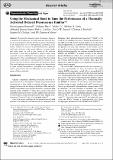Files in this item
Using the mechanical bond to tune the performance of a thermally activated delayed fluorescence emitter
Item metadata
| dc.contributor.author | Rajamalli, Pachaiyappan | |
| dc.contributor.author | Rizzi, Federica | |
| dc.contributor.author | Li, Wenbo | |
| dc.contributor.author | Jinks, Michael A. | |
| dc.contributor.author | Gupta, Abhishek Kumar | |
| dc.contributor.author | Laidlaw, Beth | |
| dc.contributor.author | Samuel, Ifor David William | |
| dc.contributor.author | Penfold, Thomas J. | |
| dc.contributor.author | Goldup, Stephen M. | |
| dc.contributor.author | Zysman-Colman, Eli | |
| dc.date.accessioned | 2021-05-06T15:30:23Z | |
| dc.date.available | 2021-05-06T15:30:23Z | |
| dc.date.issued | 2021-05-11 | |
| dc.identifier | 273153925 | |
| dc.identifier | 7a9e4d9c-9184-4847-bc0f-414b204cea0c | |
| dc.identifier | 000646325600001 | |
| dc.identifier | 85104498391 | |
| dc.identifier.citation | Rajamalli , P , Rizzi , F , Li , W , Jinks , M A , Gupta , A K , Laidlaw , B , Samuel , I D W , Penfold , T J , Goldup , S M & Zysman-Colman , E 2021 , ' Using the mechanical bond to tune the performance of a thermally activated delayed fluorescence emitter ' , Angewandte Chemie International Edition , vol. 60 , no. 21 , pp. 12066-12073 . https://doi.org/10.1002/anie.202101870 | en |
| dc.identifier.issn | 1433-7851 | |
| dc.identifier.other | ORCID: /0000-0001-7183-6022/work/90952119 | |
| dc.identifier.uri | https://hdl.handle.net/10023/23121 | |
| dc.description | Funding: P.R. acknowledges support from a Marie Skłodowska-Curie Individual Fellowship (MCIF; No. 749557). EZ-C thanks the Leverhulme trust for support (RPG-2016-047). T.J.P acknowledges the EPSRC (EP/P012388/1, EP/T022442/1) for support. EZ-C and IDWS acknowledge support from EPSRC (EP/L017008, EP/P010482/1). SMG thanks the European Research Council (Consolidator Grant Agreement no. 724987) and the Leverhulme Trust (ORPG-2733) for funding and the Royal Society for a Wolfson Research Fellowship. W. L acknowledges support from China Scholarship Council (201708060003). | en |
| dc.description.abstract | We report the characterization of rotaxanes based on a carbazole–benzophenone thermally activated delayed fluorescence luminophore. We find that the mechanical bond leads to an improvement in key photophysical properties of the emitter, notably an increase in photoluminescence quantum yield and a decrease in the energy difference between singlet and triplet states, as well as fine tuning of the emission wavelength, a feat that is difficult to achieve when using covalently bound substituents. Computational simulations, supported by X‐ray crystallography, suggest that this tuning of properties occurs due to weak interactions between the axle and the macrocycle that are enforced by the mechanical bond . This work highlights the benefits of using the mechanical bond to refine existing luminophores, providing a new avenue for emitter optimization that can ultimately increase the performance of these molecules. | |
| dc.format.extent | 8 | |
| dc.format.extent | 1712120 | |
| dc.language.iso | eng | |
| dc.relation.ispartof | Angewandte Chemie International Edition | en |
| dc.subject | Luminescence | en |
| dc.subject | Mechanical bond | en |
| dc.subject | Rotaxane | en |
| dc.subject | Supramolecular chemistry | en |
| dc.subject | TADF | en |
| dc.subject | QD Chemistry | en |
| dc.subject | QC Physics | en |
| dc.subject | DAS | en |
| dc.subject | MCC | en |
| dc.subject.lcc | QD | en |
| dc.subject.lcc | QC | en |
| dc.title | Using the mechanical bond to tune the performance of a thermally activated delayed fluorescence emitter | en |
| dc.type | Journal article | en |
| dc.contributor.sponsor | European Commission | en |
| dc.contributor.sponsor | The Leverhulme Trust | en |
| dc.contributor.sponsor | EPSRC | en |
| dc.contributor.sponsor | EPSRC | en |
| dc.contributor.sponsor | EPSRC | en |
| dc.contributor.institution | University of St Andrews. School of Physics and Astronomy | en |
| dc.contributor.institution | University of St Andrews. Centre for Biophotonics | en |
| dc.contributor.institution | University of St Andrews. Condensed Matter Physics | en |
| dc.contributor.institution | University of St Andrews. EaSTCHEM | en |
| dc.contributor.institution | University of St Andrews. School of Chemistry | en |
| dc.identifier.doi | 10.1002/anie.202101870 | |
| dc.description.status | Peer reviewed | en |
| dc.identifier.url | https://doi.org/10.26434/chemrxiv.13696483.v1 | en |
| dc.identifier.grantnumber | 749557 | en |
| dc.identifier.grantnumber | RPG-2016-047 | en |
| dc.identifier.grantnumber | ep/l017008/1 | en |
| dc.identifier.grantnumber | EP/P010482/1 | en |
| dc.identifier.grantnumber | EP/P010482/1 | en |
This item appears in the following Collection(s)
Items in the St Andrews Research Repository are protected by copyright, with all rights reserved, unless otherwise indicated.

